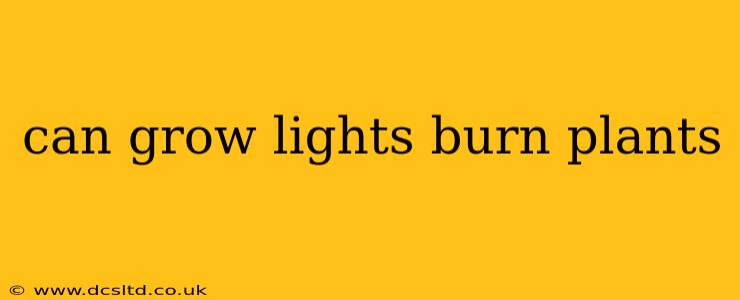Can Grow Lights Burn Plants? A Comprehensive Guide
Grow lights are essential for indoor gardening, providing the necessary light for plants to thrive. However, a common concern among plant enthusiasts is whether these lights can actually harm or even burn their beloved greenery. The answer is a nuanced one: yes, grow lights can burn plants, but this is usually due to misuse or improper setup, not the lights themselves.
This article will delve into the reasons why grow lights might damage plants, how to prevent burning, and how to choose the right grow light setup for your specific needs. We’ll also address some frequently asked questions to provide a complete understanding of this topic.
What Causes Grow Lights to Burn Plants?
The primary reason grow lights burn plants is excessive light intensity or heat. Plants need light to photosynthesize, but too much light, especially too close to the plant, can overwhelm their photosynthetic mechanisms. This leads to light stress, which manifests as scorched leaves, wilting, and ultimately, plant death.
Several factors contribute to this:
- Light intensity: High-intensity lights, placed too close to the plants, deliver more light energy than the plants can handle. This is especially true with LED grow lights, which can be very powerful.
- Heat generation: Grow lights, particularly HID (High-Intensity Discharge) lights like HPS (High-Pressure Sodium) and MH (Metal Halide), produce significant heat. This heat, combined with close proximity to the plants, can literally cook the leaves.
- Incorrect light spectrum: While less likely to cause burning, using a light spectrum not suited to your plants' needs can still lead to stress and damage.
- Lack of air circulation: Poor air circulation around the plants can trap heat generated by the grow lights, exacerbating the risk of burning.
How Close Should Grow Lights Be to Plants?
The ideal distance between your grow lights and your plants depends on several factors, including the type of grow light, its wattage, and the specific needs of your plants. There's no one-size-fits-all answer. However, a general guideline is to start with a distance of 12-24 inches and observe your plants closely. Look for signs of stress like leaf discoloration or wilting. If you see these signs, increase the distance.
Always consult the manufacturer's instructions for your specific grow light. They will often provide recommended distances for different plant types and growth stages.
What are the Signs of Light Burn on Plants?
Recognizing the signs of light burn is crucial to preventing further damage. Common symptoms include:
- Yellowing or browning of leaf tips and edges: This is often the first indication of light stress.
- Crispy or brittle leaves: Severe light burn can cause leaves to become dry and brittle.
- Wilting: Plants may wilt as a response to excessive light and heat.
- Leaf scorching: Visible brown or bleached patches on the leaves indicate severe damage.
- Stunted growth: Plants under light stress may exhibit slower growth rates.
How Can I Prevent Grow Lights from Burning My Plants?
Preventing light burn is far easier than treating it. Here are some key preventative measures:
- Choose the right grow lights: Select lights appropriate for your plants' light requirements. LED lights are generally safer than HID lights as they generate less heat.
- Maintain proper distance: Start with a safe distance and gradually adjust based on your plant's response.
- Ensure good air circulation: Use fans to keep air moving around your plants, preventing heat buildup.
- Monitor your plants regularly: Closely observe your plants for signs of stress.
- Use a light meter: A light meter can accurately measure the light intensity at your plants' level, helping you maintain optimal conditions.
What are the different types of grow lights and which is best?
Several grow light types exist, each with advantages and disadvantages. LEDs are popular due to energy efficiency and low heat output. Fluorescent lights are budget-friendly but less powerful. HID lights, while powerful, generate considerable heat and require more specialized equipment. The "best" type depends on your budget, space, and plant requirements. Researching the specific needs of your plants will guide you to the optimal grow light choice.
By understanding the potential risks and implementing these preventative measures, you can ensure your grow lights nurture your plants, not scorch them. Remember, healthy plants are happy plants, and a little careful attention to lighting goes a long way.
